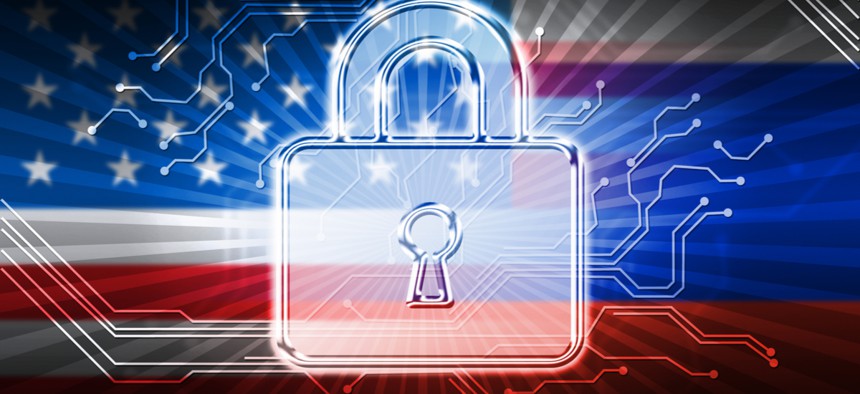How to Stop Hackers (Russian or Otherwise) from Hijacking Our Elections

Stuart Miles/Shutterstock.com
A very promising innovation in the field of cryptography may hold the answer for bolstering election technology.
Now that several weeks have passed since the mid-term elections, it’s an opportune time to look back and reflect on existing vulnerabilities in the election process and how existing technology can guarantee secure and accurate elections in the future.
Russian Interference
Ever since the dramatic ascent of Donald Trump to the White House in 2017, the question of Moscow’s meddling in the election process has occupied the news. Evidence of a coordinated influence campaign emanating from Russia is substantial but a “smoking gun” implicating the Russian government in interference has yet to be found. The real question moving forward is not “who done it” but rather what other vulnerabilities in the U.S. electoral process are exposed, and what can we do to protect ourselves?
The truth is, the danger of trolling campaigns pales in comparison to other existent threats. In the era of digital infrastructure, there are much more direct ways to influence an election. There are two main avenues that hackers could take to hack an election.
Let’s Be Honest, Voting Machines Are Not THAT Secure ...
The first is going right to the voting machines.
Breaching voting machines is not merely a theoretical possibility. At a 2017 DEFCON Hackers Conference in Las Vegas last year, participants demonstrated that these machines can be compromised by a committed attacker in less than 90 minutes. One hacking team at the conference was able to wrest control of a touchscreen voting machine and got it to play Rick Astley’s 1987 hit “Never Gonna Give You Up.” Another contestant was able to gain full remote control of a voting device from his laptop. Granted, some of the devices tested at DEFCON are no longer in use. The WinVote machine that was hacked, for instance, was retired some three years ago specifically because of security concerns. However, the wide range of methods used on a variety of machines shows that the risk of remote hacking of voting infrastructure is both real and substantial.
And Neither Are Voting Sites.
The second risk is that hackers will attack government systems in charge of overseeing elections and tallying votes. The vulnerability of voting sites caught public attention back in July 2017, when Homeland Security Department reported that as many as 21 states were targeted by Russia-based hackers “scanning election systems.” The head of department’s Cyber Division, Samuel Liles, told media that in at least some of these operations, hackers were able to access restricted areas on government sites.
There is a problem. What now?
A very promising innovation in the field of cryptography may hold the answer for bolstering election technology. The idea was first proposed by a Stanford computer scientist by the name of Ben Lynn, as part of his doctoral dissertation. Lynn’s scheme calls for incorporating pairing based cryptography (PBC) into the voting process. One of the most common forms of PBC in practice is public key infrastructure, or PKI, which forms the foundation for much of the world’s encryption technology.
PKI introduced the concept of “asymmetric” encryption; a way in which a message can be encrypted, but only unlocked by one particular user. While the public key is accessible to all and can be used to encrypt a message, only the intended recipient—the one who possesses the private key—can actually read it. Setting up PBC for elections systems would be similar to PKI in that the voter’s identity would be represented by an assigned private key. The registration authority, i.e. the Federal Election Commission, would act as the public key.
How It Would Work
FEC would first publish its own public key to be viewable by all. Each registered voter would then choose a random number that becomes their personal ID number. Each candidate’s name is then affixed to the ID number in order to construct a digital token for each candidate.
Each voter sends their personal information along with versions of their tokens that have been digitally “blinded,” disguised in order to obscure the content. To confirm that a vote has been submitted and received, the FEC would need to digitally sign all voters’ tokens. When voting time comes around, each voter submits one of the tokens along with the corresponding FEC’s signature.
Pairing-Based Cryptography Ensures Security
Using cryptographic pairing principles, FEC would not need to see the actual content of the message in order to know it’s authentic. These processes are called “zero-knowledge protocols,” or ZKP. With ZKP, at no point in the communication is the authentication data delivered by the voter exposed—not even to the recipient, in this case, the voting authority. This ensures that the data cannot be stolen or copied by those seeking to manipulate the election. FEC would be able to confidently “blind sign” all the voter’s tokens after verifying that they have been correctly constructed. The final step would involve the voter confirming his or her vote by submitting their vote along with the corresponding FEC signature for tabulation.
A Change Is Needed
The best shot we have at preventing the very real possibility of election hacking in the future is adopting a technological shift in securing election infrastructure. Innovative approaches in applying technology we already have and know how to use can provide us with the security we desperately need.
Shimrit Tzur-David is chief technology officer and co-founder of Secret Double Octopus.
NEXT STORY: What GovTech Will Look Like in 2019





